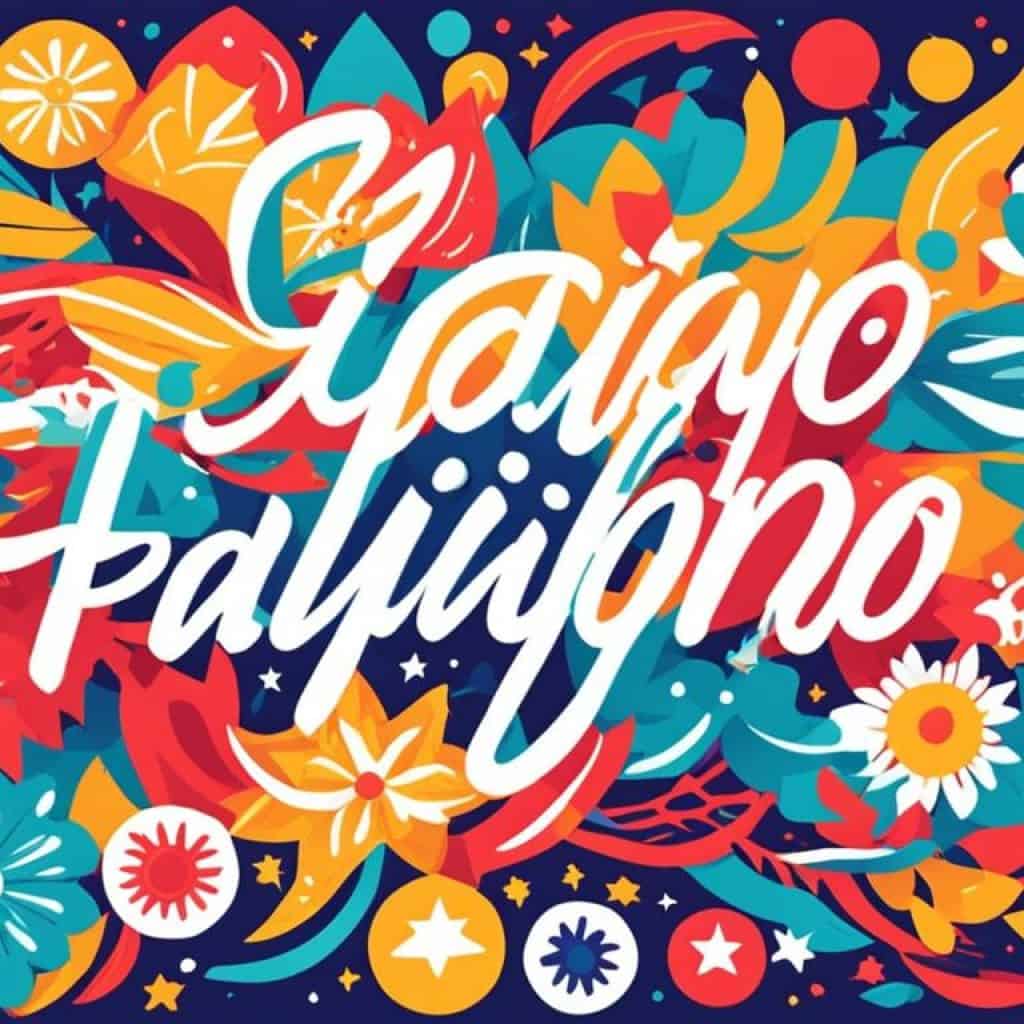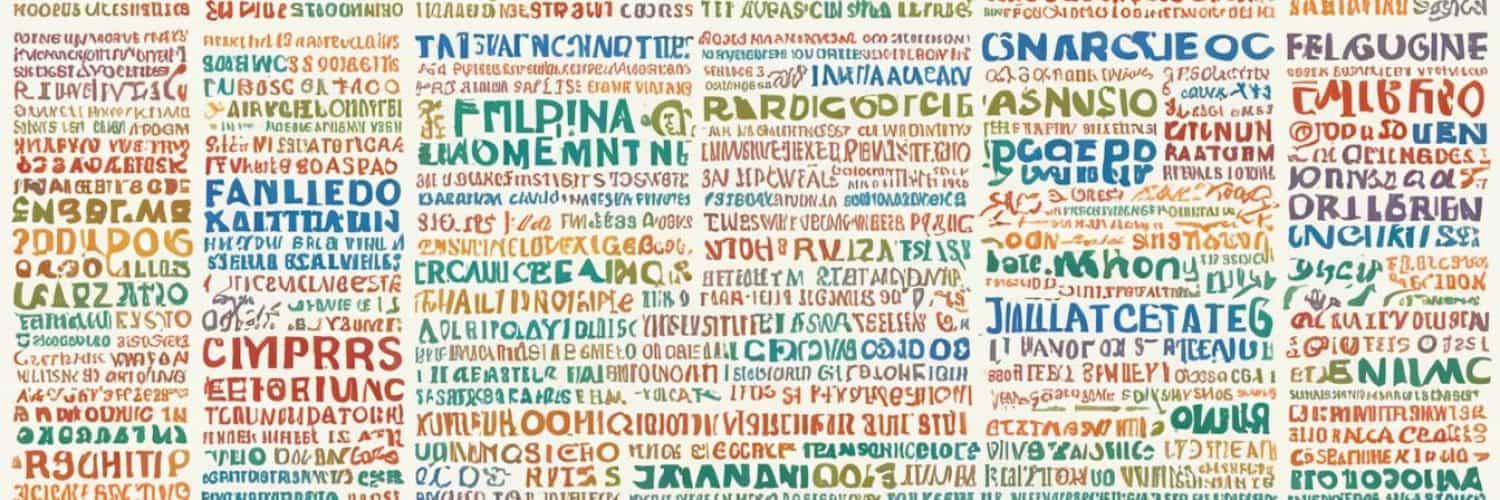What’s the difference between Tagalog and Filipino? Some think they’re the same. But, they have unique qualities. If you’ve been curious about this, you’re in good company. Tagalog and Filipino can confuse many because they seem similar. In this piece, we explore how they connect and what makes each special. We’ll look at what they share and how they’re different. Their cultural importance in the Philippines is also highlighted.
Key Takeaways:
- Tagalog is the official language of the Philippines, while Filipino refers to the people.
- Tagalog and Filipino are closely related and share a common vocabulary and grammar structure.
- Filipino is the standardized form of Tagalog and incorporates vocabulary from other Philippine languages.
- There are slight differences in pronunciation, vocabulary, and cultural connotations between Tagalog and Filipino.
- Efforts are made to preserve and promote both Tagalog and Filipino as separate languages in the Philippines.
What is Tagalog?
Tagalog, the primary language of the Philippines, is widely spoken. It is part of the Central Philippine languages. Tagalog and Filipino are often seen as the same because Filipino is derived from Tagalog. They have a lot in common, like vocabulary and grammar.
The Similarities Between Tagalog and Filipino
Tagalog and Filipino are closely linked by their history and culture. They share many words, making it easy for their speakers to communicate. The grammar of both languages is also similar, which helps in understanding each other.
“Tagalog and Filipino are like two sides of the same coin. While they are distinct, they are closely related and mutually intelligible.” – Linguistics Expert
Shared Vocabulary and Grammar
Tagalog and Filipino have much of the same vocabulary. For example, words for everyday things and family terms are almost the same. This makes it easy for speakers of both languages to understand each other.
| English | Tagalog | Filipino |
|---|---|---|
| House | Bahay | Bahay |
| Love | Pag-ibig | Pag-ibig |
| Rice | Kanin | Kanin |
Please note that the above table showcases just a few examples of the shared vocabulary between Tagalog and Filipino.
The grammar in Tagalog and Filipino is alike. They have similar sentence structures and verb forms. This makes it easy for people to learn the other language.
What is Filipino?
Filipino is the national language of the Philippines. It is based on Tagalog. It is used in schools, media, and government.
“Filipino is more than just a language – it’s a celebration of our rich heritage and identity.” – Maria Santos, a linguistics professor at the University of Manila.
Filipino is similar to Tagalog as they share many words and grammar rules. But Filipino also includes words from other Philippine languages. This makes the language reflect the Philippines’ diverse culture more accurately.
By adding words from other languages, Filipino brings people together. It helps create a common identity. It builds stronger connections among Filipinos from different regions.
Key Similarities between Tagalog and Filipino:
- Shared vocabulary and grammar structure
- Incorporation of words from other Philippine languages
- Unifying language for the diverse cultural communities in the Philippines
| Tagalog | Filipino |
|---|---|
| Primary language of the Philippines | National language of the Philippines |
| Spoken by the majority of the population | Standardized form based on Tagalog |
| Central Philippine subgroup | Includes vocabulary from other Philippine languages |
Filipino captures the spirit of the Philippines by including elements from various cultures. It unites Filipinos, making it easier for them to communicate and celebrate their culture together.
Language Differences
Tagalog and Filipino share many similarities but also differ. Differences can be in pronunciation, vocabulary, and cultural meanings. Pronunciation of some sounds might vary between the two. Vocabulary choices or idiomatic expressions may differ as well. Cultural nuances affect how words are used and their meanings, creating subtle differences.
One key difference is in pronunciation. They both have similar sounds, yet the way some sounds are pronounced can vary. For instance, how vowels or diphthongs are spoken may differ. This leads to different regional accents.
Though Tagalog and Filipino share much vocabulary, there are differences. Sometimes, they use different words for the same idea. This might be due to regional dialects or cultural preferences. The languages also have unique idiomatic expressions and colloquialisms.
Cultural context plays a role in how Tagalog and Filipino are interpreted. Some words or phrases may have different cultural meanings or emotional undertones in each language. Understanding these cultural differences is key to communicating well.
“Language is the road map of a culture. It tells you where its people come from and where they are going.” – Rita Mae Brown
Language Differences between Tagalog and Filipino
| Aspect | Tagalog | Filipino |
|---|---|---|
| Pronunciation | Variations in vowel sounds and diphthongs | Similar phonetic system with regional accents |
| Vocabulary | Overlap with regional dialects | Inclusive vocabulary from other Philippine languages |
| Cultural Connotations | Reflects specific cultural associations | Represents diverse cultural heritage |
Historical Influences
The history of Tagalog and Filipino is shaped by colonial times. Spanish rule brought in many Spanish loanwords. These words mixed with the native language, creating a special mix. Similarly, the American era influenced Tagalog and Filipino deeply.
Thanks to the Americans, English words became common in both languages. This made them richer and ready for today’s world. The blend of English has meant Tagalog and Filipino can connect globally.
Spanish and American influences have shaped Tagalog and Filipino. They have given these languages unique features.
Tagalog has about 4,000 Spanish loanwords. They touch on areas like religion, law, and everyday life. Words like “silya” (chair), “libro” (book), and “mesa” (table) show this mix.
English words also enrich Tagalog and Filipino. Terms such as “computer,” “internet,” and “television” are now daily words. This adds to the languages, especially in tech, politics, and culture.
Similarities between Tagalog and Filipino
Tagalog and Filipino are closely linked. They share many words and grammar. This lets their speakers understand each other well.
That’s why you can use Tagalog and Filipino in many places interchangeably. They’re so similar, everyone can communicate easily. Their shared roots help bring Filipinos together.
Spanish and English loans have brought Tagalog and Filipino closer. They’ve grown more alike, enriching the Filipino language. This mix has kept the languages modern and true to their origins.
In short, Spanish and English have deeply influenced Tagalog and Filipino. They’ve enriched the vocabulary and brought the languages together. Despite their differences, they share a lot, enriching the Philippines’ language scene.
| Tagalog | Filipino |
|---|---|
| Spoken primarily in the Manila region | National language of the Philippines |
| Official language of the Philippines | Standardized form of Tagalog |
| Includes Spanish loanwords | Incorporates vocabulary from various Philippine languages |
| Widely understood and spoken by Filipinos | Taught in schools and used in media and government proceedings |
Language Education
In the Philippines, people distinguish between Tagalog and Filipino. Filipino is taught in schools as a subject and used for instruction. But, Tagalog is still widely spoken and understood by most Filipinos. The decision to use Tagalog or Filipino often depends on the situation and the speaker’s preference.

Teaching languages is key to improving communication and language skills among Filipinos. The national language, Filipino, is taught to unite people linguistically. It also serves as a common way to communicate. The focus is on enhancing language abilities, including grammar, vocabulary, and reading.
Though Filipino is mainly Tagalog, there are some differences. These include variations in vocabulary and expressions, showing the diversity in dialects and customs. Students get to understand the various languages and cultures in the Philippines. They see how Tagalog and Filipino are intricately linked.
Tagalog is still frequently used in daily life. Many Filipinos speak it fluently as their first language or one they’ve learned growing up. It’s also common in media and literature, which adds to its importance in Filipino culture.
Even though Tagalog and Filipino share many similarities, they aren’t the same. Tagalog includes more regional dialects, while Filipino is used formally and is standardized. Both are culturally and historically important. Preserving them is vital for the Philippines’ linguistic and cultural diversity.
Even with Filipino’s promotion in education and official contexts, Tagalog’s ongoing use shows the complexity of the country’s language situation. Being able to switch between the two lets people adapt to different social settings.
The education system in the Philippines values both Tagalog and Filipino. It sees their study as essential to maintaining language skills and national identity. By focusing on these languages, the system helps keep the country’s linguistic diversity and cultural heritage alive.
| Tagalog | Filipino |
|---|---|
| Widely spoken and understood by Filipinos | Official language of the Philippines |
| Used in daily conversations | Taught as a subject in schools |
| Native language for many speakers | Standardized form of Tagalog |
| Varies across dialects | Incorporates vocabulary from other Philippine languages |
Language Change and Evolution
Language is alive. It grows and shifts over time. This happens in both Tagalog and Filipino due to social, cultural, and tech changes. People talking, new contexts, and blending of words mean these languages are always transforming.
The tagalog vs filipino language debate highlights their ongoing evolution and differences. Though Tagalog and Filipino start from the same roots, they’ve grown in unique ways. But remember, they’re always adapting to how people use them.
“Language is not a fixed and rigid entity; it is a work in progress, constantly shaped by its speakers and their interactions with the world.”
Society and culture hugely impact how language evolves. As these areas change, so does the language. New subcultures, dialects, and norms bring fresh words and grammar to Tagalog and Filipino. This makes the languages richer and fuller.
Technology also drives language change. New inventions mean new words. For example, “selfie,” “emoji,” and “viral” are now everyday terms. Tagalog and Filipino keep up by adding tech-related words into their vocabularies.
Language isn’t just for communication. It carries the soul of a culture, telling stories about who we are. As Tagalog and Filipino evolve, they hold onto the heart of Filipino culture and history. Adapting to change keeps them alive and relevant.
The Impact of Language Change and Evolution:
- Enrichment of vocabulary and grammar structures
- Increased linguistic diversity and cultural representation
- Adaptation to social, cultural, and technological advancements
- Preservation and expression of Filipino cultural identity
Language evolution is a natural process that reshapes how we communicate. Tagalog and Filipino grow to reflect their speakers’ lives and dreams. By welcoming these changes, they stay vibrant and true to the Filipino spirit.
Let’s take a closer look:
| Tagalog | Filipino |
|---|---|
| Primary language of the Philippines | National language of the Philippines |
| Spoken by the majority of the population | Used in education, media, and government |
| Rooted in Austronesian language family | Based on Tagalog with vocabulary from other Philippine languages |
| Evolved over centuries with influences from Spanish and English | Incorporates Spanish and English loanwords |
Language Interference
Language interference happens when one language shapes another. This can change how words are said, vocabulary, grammar, or usage. Tagalog and Filipino have been influenced by Spanish and English. Yet, they keep their unique structure and identity.
Spain and the United States once colonized the Philippines. Thus, Spanish and English greatly affected Tagalog and Filipino. Spanish brought new words to Tagalog, adding to its vocabulary.
American colonization introduced English words to Tagalog and Filipino. This added more richness to their vocabulary. The influence of these languages helped Tagalog and Filipino grow in today’s world.
Language keeps changing to meet its speakers’ needs. Spanish and English’s influence on Tagalog and Filipino shows how dynamic language is. It also showcases the cultural exchanges that guide its growth.
Even with these outside influences, Tagalog and Filipino stay unique. Some Spanish and English words have merged into their vocabularies. But the core grammar and key elements of both languages remain the same.
Table: Influences of Spanish and English on Tagalog and Filipino:
| Language | Spanish Influence | English Influence |
|---|---|---|
| Tagalog | Spanish loanwords incorporated into vocabulary | N/A |
| Filipino | Spanish loanwords incorporated into vocabulary | English borrowings expanded vocabulary |
The table shows specific influences of Spanish and English on Tagalog and Filipino. Spanish loanwords have affected the vocabulary of both. Meanwhile, English has had a wider impact on Filipino, the national language.
Despite these influences, the unique identities of Tagalog and Filipino stand strong. Language interference has made both languages grow and made them more versatile in our global community.
Language Preservation
To keep the Philippines’ diverse languages and cultures alive, it is key to protect Tagalog and Filipino as distinct tongues. There are efforts to boost their use in schools and public areas. This helps preserve the country’s rich linguistic heritage.
By taking care of Tagalog and Filipino, we make sure future generations can cherish their cultural roots. These languages are crucial for sharing stories, ideas, and traditions.
“Language is the key to understanding the soul of a nation. By preserving and safeguarding Tagalog and Filipino, we are preserving the very essence of our Filipino identity.” – Dr. Maria Garcia, Linguistics Professor
Programs in schools, literature, and media promotion are part of language preservation. Recognizing these languages in official documents is also vital.
Also, many are starting to value the Philippines’ regional languages. By documenting and reviving endangered languages, we keep our country’s cultural fabric colorful and intact.
The Importance of Language Preservation
Keeping Tagalog and Filipino distinct matters both culturally and practically.
- Preserving linguistic diversity: The Philippines hosts a wealth of languages, each significant culturally. Saving Tagalog and Filipino helps maintain this linguistic variety.
- Cultural heritage: Language ties closely to our culture, history, and identity. By preserving Tagalog and Filipino, we keep our traditions and knowledge alive through generations.
- National identity: Tagalog and Filipino help unite Filipinos across different regions. They play a key role in building a collective national identity.
Language Identity
Language shapes culture and how we express ourselves. Tagalog and Filipino are similar but have different meanings in culture. The language you pick shows where you’re from, what you like, or who you are.
Language Variation
Tagalog and Filipino languages have regional variations across the Philippines. Each region has its own set of words, pronunciations, and grammar. These differences make the language landscape in the Philippines diverse and rich.
For instance, people in different regions use unique words for the same thing. This brings variety and shows the cultural richness of each place. It highlights how language ties into local identities and customs.
Pronunciation also varies with regional accents. This leads to different intonations and sounds within Tagalog and Filipino. Such diversity in accents enriches the language even more.
Even grammar and sentence patterns change from place to place. While the main grammar stays the same, small differences in sentence building exist. These differences showcase the unique language heritage of each region.
“In the Visayas region, there’s a variant of Tagalog called ‘Waray’ that is spoken. It has distinct vocabulary, pronunciation, and grammar compared to the Tagalog spoken in Luzon.”
The table shows some regional language differences in the Philippines:
| Region | Vocabulary | Pronunciation | Grammar |
|---|---|---|---|
| Luzon | Mga bayan | ma-ga ba-yan | Pinuntahan ko ang bayan |
| Visayas | Mga bungto | ma-ga bun-gto | Ginkadtu ko ang bungto |
| Mindanao | Mga dakbayan | ma-ga dak-ba-yan | Giduyog ko ang dakbayan |
These language variations enrich Tagalog and Filipino. They reflect the Philippines’ diverse culture. Such dynamic changes show language’s ability to adapt within different communities.

Language Unity
Tagalog and Filipino unite the Philippines despite their differences. They help people communicate. They also make everyone feel like part of one culture.
Filipinos from all over use different dialects. Yet, Tagalog and Filipino bring them together. These languages help people understand each other and build community.
In daily talks, gatherings, or media, Tagalog and Filipino are key. They let Filipinos share thoughts, feelings, and values. This way, they bridge regional divides.
“Language is the road map of a culture. It tells you where its people come from and where they are going.”
– Rita Mae Brown
Tagalog is special in Manila, the heart of the Philippines. Manila’s role in politics, trade, and education has spread Tagalog and Filipino across the nation.
Tagalog and Filipino as official languages unite the country. They’re used in government, schools, and official papers. This makes them known to all Filipinos.
| Language Unity in the Philippines | Key Points |
|---|---|
| 1. Language as a Unifying Force | – Tagalog and Filipino serve as modes of communication – Foster a shared cultural identity among Filipinos |
| 2. Overcoming Regional Barriers | – Tagalog and Filipino bridge linguistic gaps – Enable understanding and connection among Filipinos |
| 3. Significance of Tagalog | – Tagalog language is a unifying force in Manila – Acts as a vehicle for spreading Tagalog and Filipino nationwide |
| 4. Official Languages | – Tagalog and Filipino are the official languages of the Philippines – Used in government, education, and official documents |
The importance of Tagalog and Filipino reaches global Filipinos, too. Overseas Filipinos use these languages to keep in touch with home and each other.
In summary, Tagalog and Filipino do more than just communicate. They’re critical for unity and identity in the Philippines. They link Filipinos everywhere, fostering pride and connection.
Language and Globalization
Globalization has increased the mix of languages and cultures, leading to exciting language exchanges. In the Philippines, languages like Tagalog and Filipino have felt the impact of global trends. They’ve absorbed new words and expressions from around the world.
This mix of global elements makes these languages dynamic. They evolve and respond to new influences. As Tagalog and Filipino interact more with the world, they pick up new words. This makes their vocabulary rich with foreign expressions. It’s a sign of the diverse cultures they encounter.
Linguistic blending boosts communication and cultural understanding. It shows Tagalog and Filipino’s ability to adapt while keeping their unique characteristics.
**Language is the road map of a culture. It tells you where its people come from and where they are going.**
− Rita Mae Brown
Globalization lets Tagalog and Filipino join global conversations, showcasing the Philippines’ rich language heritage. They easily absorb new linguistic influences. This makes it easier for Filipinos to connect with people from different language backgrounds.
Such versatility in language builds cultural understanding and promotes inclusivity. It lets people share their stories beyond borders.
The image below illustrates how languages are interconnected in our globalized world:
Interconnectedness of Languages in a Globalized World
| Language | Country/Region | Number of Speakers |
|---|---|---|
| English | United States, United Kingdom, Australia, Canada | 1.132 billion |
| Mandarin Chinese | China, Taiwan, Singapore | 1.117 billion |
| Spanish | Spain, Mexico, Colombia, Argentina | 534 million |
| Tagalog/Filipino | Philippines | 130 million |
| Arabic | Middle East, North Africa | 420 million |
The table above shows how languages spread and their importance worldwide. Tagalog and Filipino play a significant role in the Philippines’ culture, participating in the global language community.
Globalization changes how we use languages. Tagalog and Filipino keep their cultural importance while adopting global views. This fusion of languages shows the adaptability and resilience of the Filipino people in our changing world.
Language Importance
Both Tagalog and Filipino are vital in Filipinos’ everyday life. These languages are key for communication, expressing culture, and showing national identity. Protecting and boosting Tagalog and Filipino is key for keeping language variety and honoring the Filipino people’s rich background.
Tagalog and Filipino are crucial for Filipinos to talk effectively with each other. They help people from different places and backgrounds to understand and connect. This creates a feeling of unity and shared experiences.
Also, Tagalog and Filipino are important for sharing culture. Through these languages, Filipinos can share their values, traditions, and creative works. When literature, music, and other arts are in Tagalog and Filipino, they are fully enjoyed and understood.
Tagalog and Filipino also tie closely to the Philippines’ national identity. They show the nation’s diverse culture and bring Filipinos together. By taking care of these languages, Filipinos honor their unique background and feel more connected.
“Language is the road map of a culture. It tells you where its people come from and where they are going.” – Rita Mae Brown
Image:
Language Development and Trends
Language development changes with society and technology. Tagalog and Filipino show the Philippines’ rich language culture. As the country grows, these languages add new words and ways of speaking.
Global connections bring new words to Filipino. Young people use slang more, changing the language. This happens in Tagalog, Filipino, and other Philippine languages.
“Language is ever evolving, influenced by cultural shifts and societal changes.” – Linguist Maria Santos
New tech changes how we talk. Words like “selfie,” “emoji,” and “hashtags” are now common. They blend English with Filipino talk.
The Language Development Pyramid
We can see language growth as a pyramid. Each level builds on the last, making a complex language system. This pyramid shows:
| Level | Explanation |
|---|---|
| Foundation | Root words, grammar rules, and basic vocabulary |
| Intermediate | More vocabulary, sayings, and local differences |
| Advanced | New trends, borrowed words, and culture influences |
| Peak | Innovative use of language with fresh expressions |
Language doesn’t grow in a straight line. It’s shaped by history, society, media, and schools. Tagalog and Filipino’s growth adds to the Philippines’ culture.
Conclusion
Tagalog and Filipino are closely connected languages that make the Philippines rich in language and culture. They do have differences in how they sound, are used, and what they mean culturally. Yet, they share a lot of words and grammar rules. Choosing between Tagalog and Filipino often depends on the situation or personal choice. Both are vital to Filipinos’ lives.
These languages are more than just ways to talk to each other; they express cultural identity and heritage. They showcase the varied cultures and regions of the Filipino people. Whether sharing feelings, stories, or keeping traditions alive, Tagalog and Filipino are deeply embedded in Filipino culture and community.
As the Philippines grows and connects with the world, Tagalog and Filipino will keep changing and adapting. They will adopt new words and phrases to match modern life. But, keeping and promoting both languages is crucial. It helps keep the Philippines linguistically diverse and unites the nation.







Add comment